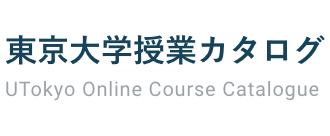過去(2019年度)の授業の情報です
学内のオンライン授業の情報漏洩防止のため,URLやアカウント、教室の記載は削除しております。
最終更新日:2025年4月21日
授業計画や教室は変更となる可能性があるため、必ずUTASで最新の情報を確認して下さい。
UTASにアクセスできない方は、担当教員または部局教務へお問い合わせ下さい。
最終更新日:2025年4月21日
授業計画や教室は変更となる可能性があるため、必ずUTASで最新の情報を確認して下さい。
UTASにアクセスできない方は、担当教員または部局教務へお問い合わせ下さい。
Special Lecture on Global Society III
History of International Relations in East Asia: New Perspectives
Course Description
This course takes a new perspective on the international history of Japan and East Asia from the beginning of the 19th century to the immediate post-war period. Our readings will challenge the traditional nation-centered approach to significant events. In addition to covering concepts such as colonialism, imperialism, conflict and war, etc., the course will also examine important issues that transcend national boundaries, including immigration (karayuki-san, Japanese Americans), environmental degradation (the Fukushima Daiichi nuclear power incident), business transactions (the expansion of the market for textile products), and ideas (Pan-Asianism). We will also incorporate crucial historical topics such as race, ethnicity, and gender by investigating the eugenics movement in East Asia, comfort women, and black internationalism, while paying specific attention to African Americans’ views of Japan. This course also addresses international history beyond the region by studying the relations between East Asian countries and the Anglosphere, especially the UK and the US. Ultimately, this course shows how international history moves across national and racial boundaries, and how history is made not only by people in power (politicians, military leaders, intellectual) but also by ordinary people.
Course Objectives:
This course will give students an opportunity to encounter new perspectives about the international history of East Asia. Students are expected to comprehend multiple dimensions of international relations, especially how “ race” has played an important role in international relations and how ordinary men and women have played significant roles in making history.
This course takes a new perspective on the international history of Japan and East Asia from the beginning of the 19th century to the immediate post-war period. Our readings will challenge the traditional nation-centered approach to significant events. In addition to covering concepts such as colonialism, imperialism, conflict and war, etc., the course will also examine important issues that transcend national boundaries, including immigration (karayuki-san, Japanese Americans), environmental degradation (the Fukushima Daiichi nuclear power incident), business transactions (the expansion of the market for textile products), and ideas (Pan-Asianism). We will also incorporate crucial historical topics such as race, ethnicity, and gender by investigating the eugenics movement in East Asia, comfort women, and black internationalism, while paying specific attention to African Americans’ views of Japan. This course also addresses international history beyond the region by studying the relations between East Asian countries and the Anglosphere, especially the UK and the US. Ultimately, this course shows how international history moves across national and racial boundaries, and how history is made not only by people in power (politicians, military leaders, intellectual) but also by ordinary people.
Course Objectives:
This course will give students an opportunity to encounter new perspectives about the international history of East Asia. Students are expected to comprehend multiple dimensions of international relations, especially how “ race” has played an important role in international relations and how ordinary men and women have played significant roles in making history.
時間割/共通科目コード
コース名
教員
学期
時限
31D350-0420S
GAS-GS6A42L3
Special Lecture on Global Society III
堀田 千里
月曜5限
講義使用言語
英語
単位
2
実務経験のある教員による授業科目
NO
他学部履修
可
開講所属
総合文化研究科
授業計画
Headline ( & Class Schedule)
Week 1(4/8): Setting the Stage: What is imperialism? Was Japan threatened by imperialism?
Week 2( 4/15): Japanese Immigration in the Early Meiji Period: Was Expansionism the National Strategy?
Week3(4/22): The Development of Japan’s Colonial Empire
Week 4( 5/13): Japan’s Industrialization: The Cotton Textile Industry
Week 5(5/20): Road to the Asian Pacific War
Week6(5/27): The Outbreak of the Asian Pacific War and its Impact on Japanese People in the U.S.
Week7(6/3): Feminism and the Eugenics Movement in East Asia
Week 8(6/10): Solidarity among Colored People?: Pan-Asianism vs. Black Internationalism
Week 9(6/17): The Post-War Period: Japan under the U.S. Occupation
Week10.(6/24): The Cheju-do Rebellion and the Origins of the Korean War
Week 11(7/1): The Outcome of the Korean War and the Repatriation of Korean Residents in Japan
Week 12(7/8): Present-Day Controversies: Japanese School Textbooks and the Comfort Women
Week 13(7/15): Environmental Crisis: The Fukushima-daiichi Nuclear Power Incident and Its Impact & wrap-up
授業の方法
Course Requirements:
The format of this course will be short lectures with frequent discussions and presentations. All students are expected to read the assigned articles and books thoroughly before class and prepare questions for class discussions. Each student is also expected to give one presentation based on close and careful readings of course materials. In addition to books and articles, the assigned materials will include YouTube videos and other media.
Discussion Questions
During class discussions, all students are required to ask one question about the assigned readings (articles, chapters).
Final Paper
Students should write a 6-7 page paper based on themes relevant to this course. Before starting to write this paper, you must submit a brief synopsis. The final paper is due on July 15.
Language Used in Class: English
成績評価方法
Grade Evaluation
Active participation in class : 25 %
Discussion questions: 10 %
Oral presentation: 20%
Paper synopsis: 5%
Final paper: 40%
The class participation grade will be based on students’ preparation for and contributions to
class discussion.
教科書
-
参考書
Course Materials(1/2):
Aydis Cemil. “ Japan’s Pan-Asianism and the legitimacy of Imperial World Order, 1931-1945.” The Asian Pacific Journal, 3-6, March 3, 2008.
Azuma Eiichiro. “ Pioneers of Overseas Japanese Development”: Japanese Americans History and the Making of Expansionist Orthodoxy in Imperial Japan.” The Journal of Asian Studies, Vol 67, No.4(November )2008: 1187-1189.
Best Anthony. “ The Anglo-Japanese Alliance and International Politics in Asia, 1902 -23.” Anthony Best ed. The International History of East Asian, 1900-1968: Trade, Ideology, and the Quest for Order. London and New York: Routledge, 2010. pp. 21-34.
Bill Mihalopoulos. “ Women, Oversea Sex Work and Globalization in Meiji. The Asian Pacific Journal, 35-1-19, August 26, 2012
Chan Sucheng. “Changing Fortunes, 1941to 1965,” Asian Americans: An Interpretive History. New York and London: Twayne Publishers, 1991. pp. 121-142.
Cheju-do Rebellion. www.columbia.edu/~hauben/jeju/Jeju_Island_1945-1946.
Cumings Bruce. Korean’s Place in the Sun: A Modern History. New York and London:
W.W. Norton & Company, 1997. Selections.
Duus, Peter. “ The Origins of Meiji Imperialism,” Abacus and the Sward: The Japanese Penetration of Korea, 1895-1910. Berkeley: University of California Press, 1995. pp.1-25.
————. “ Defining the Koreas: Images of Domination, “ Abacus and the Sward: The Japanese Penetration of Korea, 1895-1910. Berkeley: University of California Press, pp.397-423.
————. “Zaikabo: Japanese Cotton Mills in China, 1895-1937,” Japan’s Informal Empire in China, 1895-1937. Peter Duus, Ramon H. Myers, and Mark R. Peattie, eds. Princeton, NJ: Princeton University Press, 1989. pp. 65-100.
Gordon, Andrew. “ Social, Economic , and Cultural Transformations,” A Modern History of Japan. New York & Oxford: Oxford University Press, 2002, pp.94-114.
Hicks, George. “ The Comfort Women” in The Japanese Wartimes Empire, 1931-1945. Duus, Myers, and Peattie eds. Princeton, NJ: Princeton University Press, pp.305-323.
Holt Thomas. “ Race and Racism, “ Encycropedia of American Political History, ed. Jack O. Green, p.1044.
Horn Gerald., Facing The Rising Sun: African Americans. Japan, and the Rise of Afro-Asian Solidarity. New York: New York University Press, 2018( selections).
Huffman L. James, Japan and Imperialism, 1853-1945. Ann Arbor, MI , Association for Asian Studies, Inc, 2017. pp.1-21.
Inokuchi Hiromitsu.” Korean Ethnic Schools in Occupied Japan, 1945-52.” in Koreans in Japan: Critical Voices from the Margin. Sonia Ryang , ed. New York: Routledge, 2000, pp.140-150.
Irokawa, Daikichi. The Culture of the Meiji Period. Translated by Jensen Morris, Princeton, NJ: Princeton University Press, 1985 (selections).
“Japanese Interment Camp,” http://www.history.com/topics/world-war-ii/japanese-american-relocation.
Jacob Robert, “On Forgetting Fukushima,” The Asian Pacific Journal. 5-1-14, March 3, 2016.
Morris-Suzuki, Tessa. “ Freedom and Homecomings: Narratives of Migration in the Repatriation of Zainichi Koreans to North Korea.” Diaspora Without Homeland: Being Koreans in Japan. Berkeley: University of California Press, pp.39-61.
Otsubo Sumiko and Bartholomew James, “ Eugenics in Japan: Some Ironies of Modernity, 1883-1945,” Science in Context II, 3-4(1998), pp.545-565.
Selden Mark and Nozaki Yoshiko, “ Japanese Textbook Controversies, Nationalism, and Historical Memory: Intra-and Inter-national Conflicts,” The Asian Pacific Journal , 24-5-7, June 15, 2009.
Shimizu Hiroshi. “ Karayuki-san and the Japanese Economic Advance into British Malaya, 1870-1920.” Asian Studies Review. Volume 20, 1997-Issue 3, pp. 107-132.
履修上の注意
Course Materials(2/2):
Smethurst Richard J. “Japan, The United States, and the Road to World War II in the Pacific.” The Asian Pacific Journal 37-4-10, Sep. 9, 2012.
Szpilman W.A. Christopher and Sven Saaler. “Pan-Asianism as an Ideology of Asian Identity and Solidarity, 1850-Present.” The Asian Pacific Journal , 17-1-9, April 25, 2011.
Van De Ven Hans. “ Bombing, Japanese Pan-Asianism and Chinese Nationalism” Anthony Best ed. The International History of East Asia, 1900-1968: Trade, Ideology and the Quest for Order. pp. 99-117. London and New York: Routledge, 2010. pp. 99-117.
Yuehtsen Juliette. “Better Science and Better Race?: Social Darwinism and Chinese Eugenics,” A Journal of History of Science Society,VD Dec.105(4), 793-802.
Supplemental Readings:
Gallicchio Marc. The African American Encounter with Japan and China: Black Internationalism in Asia,1895-1945. Chapel Hill and London: The University of North Carolina Press, 2000(selections).
Kearney, Reginald. Afro-American Views of the Japanese: Solidarity or Sedition? Albany, N.Y. : State University of New York Press, 1998( selections).
Merril John. “The Cheju-do Rebellion.” https://www.slideshare.net/burnebok/ppt-the-chejudo-rebellion
Marston Daniel. “ Stop over the Pacific.,” Pacific War: From Pearl Harbor to Hiroshima. Oxford, United Kingdom: Osprey Publishing, 2005. pp. 15-28.
Woodruff D. Smith. European Imperialism in the Nineteenth and Twentieth Centuries. Chicago: Nelson-Hall, 1982 (selections).
A list of readings will be provided on the first day of class.
Since this syllabus is worked out in advance as a guide to the course. I reserve the right to modify it if it is necessary. Should a change be made, an announcement will given in advance.





 大学院
大学院

 マイリストに追加
マイリストに追加
 マイリストから削除
マイリストから削除


